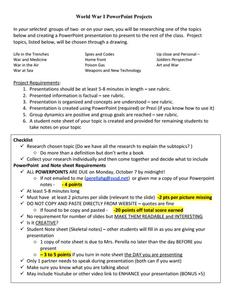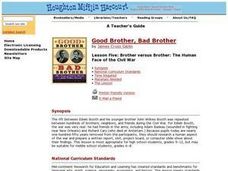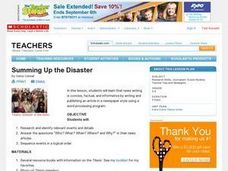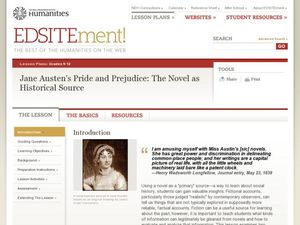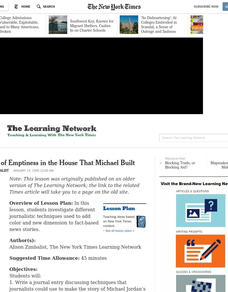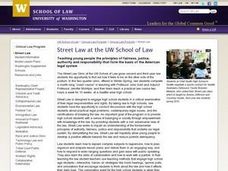Curated OER
That #!%@! English class
Students research the Alameda story. They interview English teachers, curriculum experts, parents, etc. to view their intake on the story line. Students conduct research on issues and interests by generating ideas and questions on a...
Curated OER
Desert Views: First Impressions
Students are introduced to primary source material and the ways in which early travelers viewed aspects of the desert environment. The lesson addresses the geography themes of location, region, and human/environment interaction.
Curated OER
Snapshot Snippets
Sixth graders list facts they have learned about the Alamo from their analysis of the Alamo images from The Real Alamo portion of this lesson. They then list 20 facts about the Alamo building, symbols, and Texas history.
Curated OER
Thesis Statements
A good thesis is hard to craft. Model for your writers how to develop and refine thesis statements with a series of slides that discuss the purpose and format of this all-important sentence. Viewers following along as the process is...
Seneca Valley School District
World War I PowerPoint Projects
Use these project guidelines as a start to designing your own class PowerPoint project and to consider what elements you would like to assign and assess in your class. While the resource begins with instructions for researching World War...
English Enhanced Scope and Sequence
Media Literacy with Focus of Strategies for Collaboration
Introduce your class to literary analysis with a series of activities that has them examine book and movie reviews. Groups then draft their own review of a text, select a digital medium, and craft a presentation.
Novelinks
The Good Earth: Multigenre Writing Strategy
In response to reading Pearl Buck's The Good Earth, individuals are asked to complete a multi-genre writing assignment, crafting eight different pieces including a research paper.
Curated OER
Brother versus Brother: The Human Face of the Civil War
Students research a human aspect of the Civil War and prepare a written report, skit, project board, or computer slide-show about their findings. They focus on how the war affected families who had members on opposing sides of the conflict.
Curated OER
Drawing Political Cartoons
Students draw political cartoons. In this editorial cartoons lesson, students discover the history of the cartoons in America, analyze some cartoons, and then draw their own cartoons that make social statements.
Curated OER
Animal Report
Fourth graders explore the variety of resources available to them at the library. They utilize many of these resources to create an animal report with a set criterium.
Curated OER
Concern in East Virginia
Students investigate the statehood of West Virginia. In this lesson on statehood, students use primary sources to examine the separation of Virginia from Wes Virginia. The lesson incorporates a field trip as a means to put knowledge into...
Curated OER
Federalism
Students become familiar with the Federalist papers and the work of the federal government. In this federalism lesson plan, students find similarities and differences between state and federal government.
Curated OER
Let's Get Moving
Students participate in sports activities that relate to motion, velocity and momentum. They produce a PowerPoint presentation after researching the activities.
Curated OER
Summing the Disaster
Students assume the role of a newspaper editor during the time of the Titanic disaster. They must search out the accurate answers to the questions: What? When? Where? Who? and Why? students then write their own newspaper article...
Curated OER
We Are Lunar tics!
Second graders, working in cooperative groups, will create a multimedia presentation about the Earth's moon. Their research must be presented through three or more methods. (i.e. charts; graphs; oral reports; multi-media; dramatic role...
Curated OER
Jane Austen's Pride and Prejudice: The Novel as Historical Source
Students examine historical fiction as historical sources. In this historical fiction instructional activity, students analyze excerpts from Jane Austen's Pride and Prejudice as well as Mary Wollstonecraft's A Vindication of the Rights...
Curated OER
Food Journal Exercise
Students are required not to change their usual eating pattern while recording everything they eat and drink for 1 day. They evaluate the nutrient composition of their diet, as well as their dietary intake and behavior within the...
Curated OER
Robert Boyle and the Mechanical Philosophy
Students read and discuss Boyle's Mechanical Philosophy and his rejection of Aristotle's theory of "Forms and Qualities." They answer a given set of questions and discuss these with the class.
Curated OER
Designing "Green" to Save Our Green Planet
Students design an environmentally friendly home. In this middle school math/science lesson, students watch videos on creating green design. Students work in collaborative groups to determine what makes a house green and to design a...
Curated OER
A Sense of Emptiness in the House That Michael Built
Students investigate different journalistic techniques used to add color and new dimension to fact-based news stories. They write a journal discussing techniques that journalists could use to make Michael Jordan's retirement from the NBA...
Curated OER
Political Science: Political Analysis Through Satire
Students identify, analyze and explain examples of politcal satire. They discuss the role of political satire in the democratic process and create and present examples of political satire.
Curated OER
Reality Film
Learners propose and create documentary films depicting a slice of "ordinary" life that reveals something unique or surprising about its subject. They, in groups, make films and present them to the school.
Curated OER
Tort Law
Students study the concept of negligence. They recognize the difference between civil and criminal law and examine the factors that courts consider when considering if there is a duty and whether it has been breached. They argue either...
Curated OER
Mammal Facts and Myths
Students write a report. In this mammals lesson, students learn about various mammals such as whales, beavers, bats and echidnas. Students make a diagram, write a report, brainstorm a list of myths and make a model animal.






